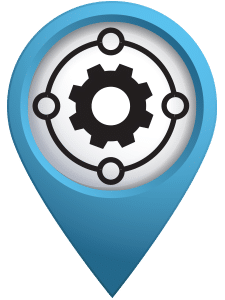
In our first blog, we introduced a new map to help identify where your company is and a path to more quickly get where you want to go. By way of review, the map identified six destinations of companies from Start Up to Legacy. These six are: Planting, Drowning, Grinding, Scattering, Evolving, and Transcending.
The Transcending Stage is the sixth and final destination we are unfolding in more detail. As before we will identify each destination’s signs, paths, obstacles, and states of heart. At a 30,000-foot view, below is what the destination of Transcending looks like:

Now, we will drill down into “Transcending” to help it come to life.
The Transcending Stage: The Signs and the Paths
The Transcending Stage is where long-term-minded companies long to reach…the pinnacle. From a company perspective, you have a truly unique value proposition. The market has not only recognized but values your offering. You endured the rough and rugged climb—and now—the view from the summit is far and wide.
The word “transcend” comes from 2 Latin words, trans (across) and ascendere (climb.) You get the picture of a climber, grappling and zigzagging up jagged ridges to finally crawl over the last crest to the mountain top. A great deal of growth (from struggles, blood, sweat, tears, and toil) was the result of being in the difficult valleys, and, of course, in the many challenges of the steep climb. You were primed to persevere with strength and keep your values at the forefront.
The Journey
Through learning and adjusting to constant demands you have built and retained a solid team. No longer do you cringe and scrape at the blinding rock face, but feel a hands-free release and relief as you step on solid ground. What is beyond…now that you have risen above?
The Transcending Stage can be one of the most challenging, as it takes a combination of awareness, leadership, vision, and unity. It’s time to seriously focus on your personal and corporate legacy. The vision shifts to becoming a force for good and leaving a long-term impact. How will the next generation remember you? What can you leave behind that is meaningful and purposeful?
Transcending is about creating legacy. Winston Churchill defined legacy in his own way, with only a few words. He simply said, “You make a living by what you get. You make a life by what you give.”
Signs you are in the Transcending Stage
The first sign of Transcending is that your company consistently amplifies its strengths and values. Peter Drucker, well-known management consultant has said, “You cannot build performance on weaknesses. You can only build on strengths.”
Strengths, Values, and Purpose
A second sign you are in the Transcending stage is that your executive team’s strengths, values, and purpose are clear to each member. Author Dr. Henry Cloud defines “value” this way, “What we value is ultimately what we enforce and stand for.” To “value” means to hold something precious or of high worth. The things we value are worth fighting for. They are also the structures that organize our efforts into focused activity, with the aim of producing more of what we value.” It is probable that frequently restating your company’s principles can bring about revitalization in your company. This action, in turn, can help foster continuous motivation, inspiration, and creativity.
The Team has Grown and Jelled
A third sign in journey is that you have built a solid and effective leadership team. “It is teamwork that remains the ultimate competitive advantage, both because it is so powerful and so rare,” according to Patrick Lencioni, a successful author of business management books. You are confident that effective systems and processes are in place, and your staff has the right experience and skills to move the company forward into the next decade and beyond.
The Focus on Generational Future Value
A fourth sign you are in the Transcending Stage is that a strategic 10-30-year plan is in play. As founder, you are able to focus on the legacy you want to leave for future generations. A good example would be American entrepreneur Jim Rohn. He was a self-made millionaire by the time he was 31 in direct sales. His focus shifted to become one of the most influential and motivational speakers on personal development. He wrote 17 books and died at age 79. He implored other business owners to develop a clear focus and path: “All good men and women must take responsibility to create legacies that will take the next generation to a level we could only imagine.”
The Path Will Have Obstacles
While on the path to, or in the Transcending Stage, here are some of the obstacles you may encounter along the way.
Obstacle 1: Others Don’t Get My “Why”
As a founder, your “why” has driven you. As you transition, your staff may not have the same level of clarity or understanding of your values and/or vision. Not every leader has the same ability to create or cast vision. Without careful planning, preparation, and relational care, team members might not be able to grasp their purpose, or to share the same goal. Now, preparing and delivering effective communication, whether one-on-one, face-to-face, digital, print, or video, becomes a key focus to transfer thoughts, motives, and feelings.
Lack of Clarity Trap Symptoms
- One symptom is that the core executive team is more concerned with solving the problems of the day versus growing future leaders. The team focuses more effort on identifying what is not working. While problems are easy to spot— good processes, a strong echo system, and relationships can get overlooked.
- A second symptom is that there is no interest in imparting information in new and different ways to keep values and purpose clear. It might be that discussion materials and methods are not current and need updating. Additionally, a statement of values and original company history is non-existent in onboarding new hires.
- A third symptom is not having a clear map of what a transition will look like, plus an indication of areas that need to be changed. Without a map of these areas, and without a checklist to see if they have been completed, a loss of organizational effectiveness and value can take place.
Obstacle 2: Role Clash
Role clash can often be an obstacles in the Transcending Stage. You may notice that there is a strong undercurrent of relational friction. Each leader struggles to not only “sense,” but to create with the “end in mind.” Adjusting to different styles of governance is difficult for the founder and other leaders. There is also a concern on the owner’s part to “not wreck it—” to not unravel all the hard work it took to build the business. For instance, the founder might be a high-vision leader, but an emerging successor might not be. Some questions that founders need to ask are, “How enmeshed in the strategy and daily operations do I remain?” “How distanced do I want to be?” “How flexible can I be?”
Role Clash Trap Symptoms:
- You know you have fallen into this trap when there are frequent feelings of fear, anxiety, or anger due to the uncertainty and misunderstandings that can arise from all leaders—especially the founder. A common problem is that there is a clash in age, style, personality, experience, or skill set. In this case, team members do not feel unified and may remain siloed in their roles, as there is no purposeful overlap.
- Another symptom is that there is no strategy, or no envisioning of length of tenure. As founder, success has happened by learning, adjusting, and performing for a given stage of growth. A good question to ask would be, “Is staying on as “head of the ecosystem” a healthy and wise option? What is my ideal work/life balance?”
It takes time and a plan to identify and evaluate successors and to analyze the value of the company and its assets. While preparing for a role focused on future generational value, it may sometimes appear that the founder is still playing the role as the head of the ecosystem, rather than building new space for a successor to rise up to it.
Obstacles 3: Seesaw Leadership
Some leaders always like to be “above,” and do not value partnership. Mutual respect can produce a comfortable equilibrium, which makes imparting ideas and solutions much easier. But sometimes a founder and successor can repeatedly bounce the other up or down causing surprising and painful bumps. Questions to ask are, “Are we all committed to the same vision and principles? How can we collaborate better?”
Seesaw Trap Symptoms:
- One of the symptoms is that the founder is too involved in the team’s planning. There are too few boundaries…and a feeling on the team’s part, that the owner is not letting go. The founder may be unable to shake the habit of “hands-on,” rather than adapting to “hands-off.” The founder feels like the head of the ecosystem, but the emerging leader/successor also feels the same.
- A second symptom is that there is no plan for relational development and care of the executive team. A lack of unity among staff is palpable. There is no focus or discussion of long-term growth and legacy. Bestselling leadership author, Daniel H. Pink, writes about 6 traits that make a job meaningful. These traits are authenticity (being your true self;) agency (exercising autonomy;) self-worth (feeling valuable;) purpose (an urgent goal;) belonging (a shared identity;) and Transcendence (a greater cause). Planning to allow time and effort for the leadership team to work on, and acquire these traits is critical for long-term success.
Impacts of the Obstacles and Traps
These obstacles and traps are roadblocks that can obstruct the steady and smooth personal, and physical transition of a company to a successor. Each trap causes irritation and anxiety, rather than positive emotions of anticipation, joy in contributing, peace, and excitement. The feeling that every exit is a new entrance, becomes overpowered by loss of identity, or fear.
Paths to move from idea to results:
- Create a Board. Recruiting experienced outside professionals with varied perspectives is a great way to obtain guidance, plus position the company to implement a strategic 10–30-year plan. The TEAM approach, Together Everyone Achieves More, often gets better results that siloed thinking, or the traditional top-down leadership model.
- Plan for a successor. You don’t want a messy situation and you don’t want to lose value or have the company derail in transition. To avoid potential challenges, you will have to focus on staff development, assess future needs, analyze, create a plan, and train emerging leaders.
- Embrace the founder role. Every exit is a new entrance. New goals and endeavors are a key part of creating future value. The founder focus needs to move from operating a company to creating legacy and value.
- Define lateral markets. One area for value expansion is tackling a lateral market. Understanding core competencies that can transcend the current model can provide an avenue for creating future value. Which systems or processes can produce innovative products and services? What are the needs, uses, situations of customers? What are the trends, economic conditions, future outlooks?
- Develop a transition and/or exit plan. This exit plan can be a comprehensive reimagining of exit options and objectives. It can include a timeline for all aspects of the business (personal, financial, legal, tax, and value creation.) It can also include recapitalizing the business for its future growth needs.
Transcending Stage Success:
The big picture view is that a diligent owner has realized the strategic plan that has formally, or informally, been in place since the company’s start-up. The founder’s role changes. The role is not just newly defined, but embraced wholeheartedly. There has been a physical and emotional “letting go,” or release of the previous role. The founder has become fully engaged in leaving a long-term impact and legacy for the next generation.
Team Dynamics
The role changes made results in a solid leadership team with different skill sets that will carry on the company’s values and strengths. All leaders feel clarity in their roles, share the same goals, and feel excitement for the future. They will continuously strive to persevere through a feasible long-term strategic plan. Job satisfaction has reached a high level. There is unity, synergy, and a shared sense of contribution to the next generation.
Succession
In addition, there is a satisfactory transitional or exit plan in place. The founder feels peaceful and inspired to dream new possibilities and to begin new endeavors that drive future value. The successor feels motivated to assume new responsibilities and is well-positioned and trained to thrive wearing the new mantle of leadership.
To imagine a physical hand-off, think of an Olympic relay race in which a determined runner gains great speed and distance while clutching the baton— and then diligently upsweeps, downsweeps, or push-passes the baton into the next runner’s right hand (the “handover.”) A new individual race begins, but the win belongs to the TEAM.
Legacy
Stephen R. Covey, best-selling author of 7 Habits of Highly Successful People, shares his philosophy on succession planning in the following statement, “The need to leave a legacy is our spiritual need to have a sense of meaning, purpose, personal congruence, and contribution.” Creating a hope and future for the next generation is what is at the heart of Transcending.
Success is when I add value to myself.
Significance is when I add value to others.
John C. Maxwell
Proverb 22:1
Choose a good reputation over great riches;
being held in high esteem is better than silver or gold.
Luke 14:28
28 For which of you, desiring to build a tower, does not first sit down and count the cost, whether he has enough to complete it?




0 Comments